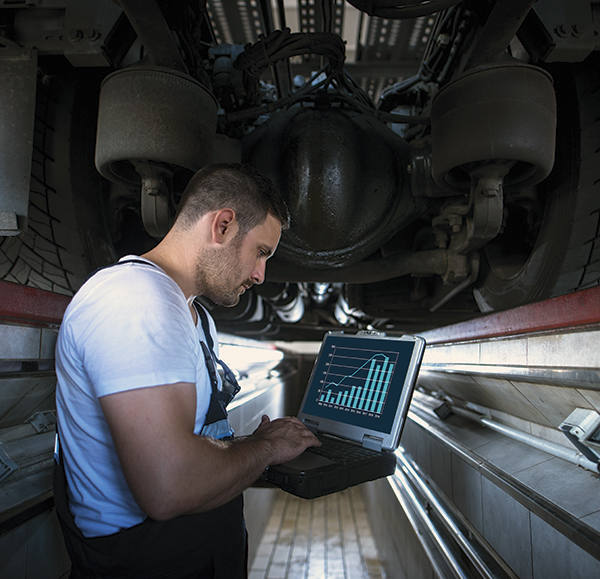A telematics system allows work truck fleet professionals to capture and analyze meaningful data about a fleet’s operation—information they can use to improve productivity, reduce downtime, and save money. Or at least that’s how they are advertised. Three fleet professionals invested in telematics for their work trucks and equipment. Below they weigh in on how their companies use the data to tackle challenges and optimize performance in their fleets and whether they think telematics systems are all they’re cracked up to be.
WHAT WERE YOUR EXPECTATIONS ABOUT TELEMATICS BEFORE YOU PURCHASED A SYSTEM?
BRANDON GARRETT,
fleet manager, Carter Machinery:
When we first invested in telematics, it was driven by fuel expense management. Fuel prices were through the roof, and we were trying to get our arms around how to control that expense. We were also trying to understand what was driving our fuel costs other than price per gallon.
SCOTT CLINE,
fleet manager, Wheeler CAT:
The biggest thing was to make sure our telematics system collected in-state and out-of-state miles.
WHAT HAS CHANGED FOR YOUR FLEET WITH USE OF TELEMATICS?
CLINE:
One of the biggest changes is how we make better decisions with our equipment. Telematics has become an integral part of everyday use. It also allows us to do a lot of accident investigations. We’ll also install all the equipment, whether it’s an all-in-one power system, a welder, or a crane. Telematics can track information from that equipment. The other big thing is that it’s allowing us to dispatch differently. We can look at a job to see if a big truck is needed, so we don’t waste time and money sending a big truck every time. It also gives us a much quicker response time to our customers.
DAN SMITH,
VP of product support,
Roland Machinery:
There’s a lot of data. And it’s really just understanding and having the time to analyze that data correctly and then putting that into a program or a policy change and monitoring it.
HOW DO YOU USE TELEMATICS IN YOUR FLEET, AND WHAT KIND OF DATA ARE YOU TRACKING?
CLINE:
Telematics runs on all of my vehicles, and I analyze data on 270 trucks every day. Before we had telematics, I could maybe get to two or three trucks each day to see the information. I had to call that technician and have them get the information off the truck. Now I can pull reports and drop information into Excel to see everything I need to see. It tells me the vehicle replacement rate, repairs and maintenance, and bill usage. For me, a big part of using telematics is goal setting. Do I just want to reduce costs, or do I want to improve uptime for my drivers? How do I optimize our equipment to keep the downtime minimal for those drivers?
GARRETT:
We use telematics on our service-related assets because they drive our fuel expenses. We get a better understanding of idle time and its correlation with fuel expense. We can also understand the differences in idle time by region and measure productive versus nonproductive idle time. For example, we can tell if it is different in our mining region versus our construction region. We also frequently use the data to go back and try to understand IRP/IFTA fuel reporting metrics. And we use it for maintenance, understanding what the current hours are on a piece of equipment. We get ignition on/off data, location data, diagnostic trouble codes, and information about driver behavior such as speed alerts, harsh braking, and acceleration.
SMITH:
You might have an operator who for some reason burns more fuel than another operator, even though it’s the same machine and the same work. Telematics data helps us understand why that might be so we can use it for training opportunities. It’s a part of our daily operations. It makes us more efficient, especially on the sales and support side, because we’re developing routes and weekly travel schedules based on some of the mapping we can do. On the field service side, it has made us more efficient in situations where we know a technician is out on a light job that won’t take him very long. We can send him to another job, because we can see which technician is closest.
HOW DOES TELEMATICS AFFECT TRUCK REPAIR AND MAINTENANCE IN YOUR FLEET?
CLINE:
We can see how many hours and how many miles are on the vehicle, so we have a better idea of how often we need to down a vehicle. We can plan maintenance to help prevent some of the breakdowns. It gives us options. We can look at technicians’ schedules and plan the maintenance or repairs around those times, which helps us tremendously. We can make a strategy on how to effectively do this, and it gives us more communication between the fleet department and the supervisor of that technician, as well as the technician.
GARRETT:
Now with the data, we can do a little bit better. We’re not necessarily only looking at the odometer reading. It’s also the engine hours. The technicians now understand that it’s important to focus a little bit more on engine hours. You could push a truck to whatever the maintenance interval is on an odometer, but it might have needed two oil changes in that time in terms of engine hours. Before, we never really had any visibility to that.
WHAT IF YOU LOST TELEMATICS ON YOUR FLEET TODAY?
CLINE:
It would cripple a lot of stuff I can do, and it would probably force me to hire at least two full-time positions. Previously without telematics, I had to collect every field receipt and review them to make a log showing where they drove, how many miles they drove every day, and in which jurisdictions. If the miles were in different states, you had to compile that data for each quarter and submit it along with information about fuel purchases. It was about a 40-hour report. Having telematics cuts that down significantly.
SMITH:
We could not exist today without the data we get from telematics. We monitor every single system on every single machine. We have over 3,000 pieces of mobile equipment and 140 field service trucks that our telematics team is monitoring daily. We get alerts, and we know exactly what systems are failing. Telematics on the equipment is indispensable.
WHAT WOULD YOU SAY TO ANOTHER FLEET MANAGER CONSIDERING TELEMATICS?
CLINE:
If you’re not using telematics, you’re tying your hands behind your back regarding what you can do with your fleet and how it can help your company, your customers, and your employees. It allows us to be more efficient.
GARRETT:
There are definitely benefits. Make sure you understand what you want to accomplish with telematics before you jump on. Find a provider that can give you the full spectrum of what it is you need—not just one piece of it. Make sure you understand what it is you’re trying to accomplish, and be careful of data overload.
SMITH:
The first and foremost question is, “What do you want out of it?” What is driving your need to do this? That dictates what kind of system you need.
IMPROVE RESULTS
When a work truck is down, it isn’t productive or profitable. A truck that isn’t used efficiently or effectively can also drive fleet costs higher. According to these fleet professionals, fleet managers can better track work truck and equipment usage and maintenance needs with the right telematics system.
FOR MORE INFORMATION
Find out more about work truck solutions and the benefits of telematics for your fleet, visit www.millerwelds.com/worktruck.




